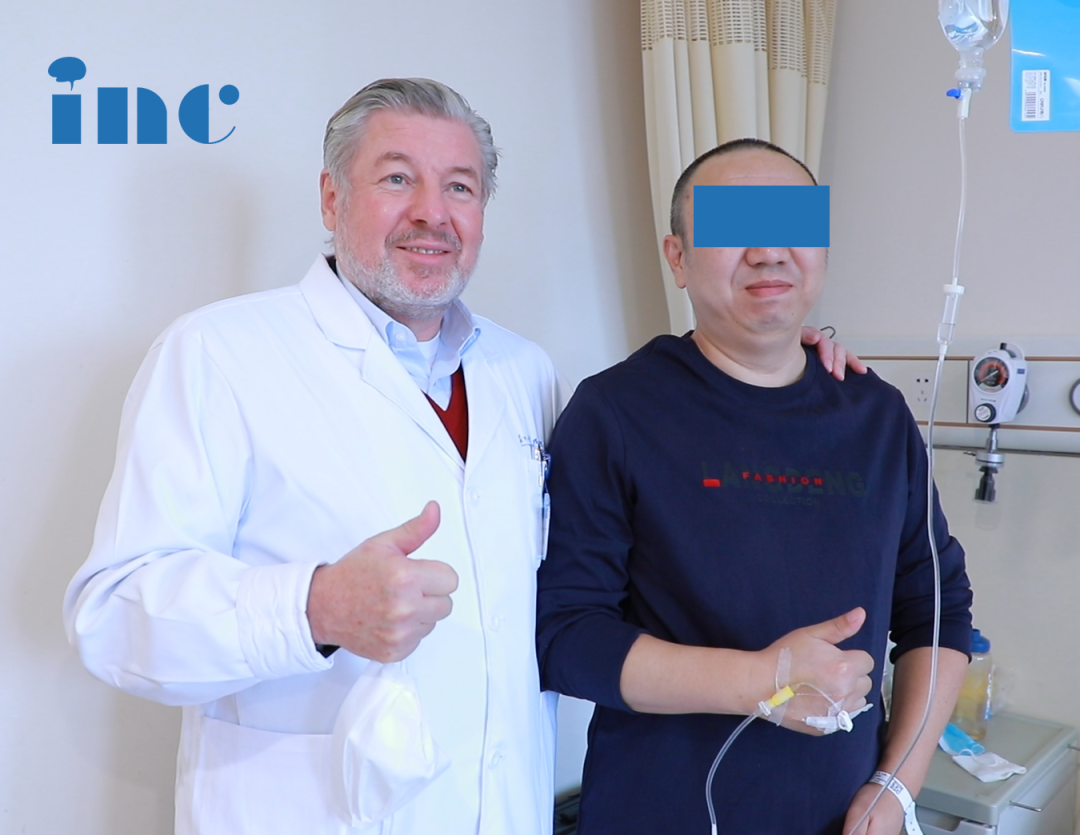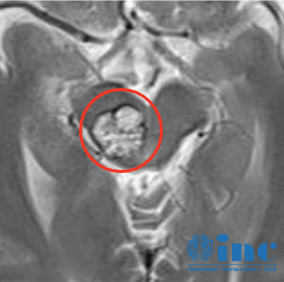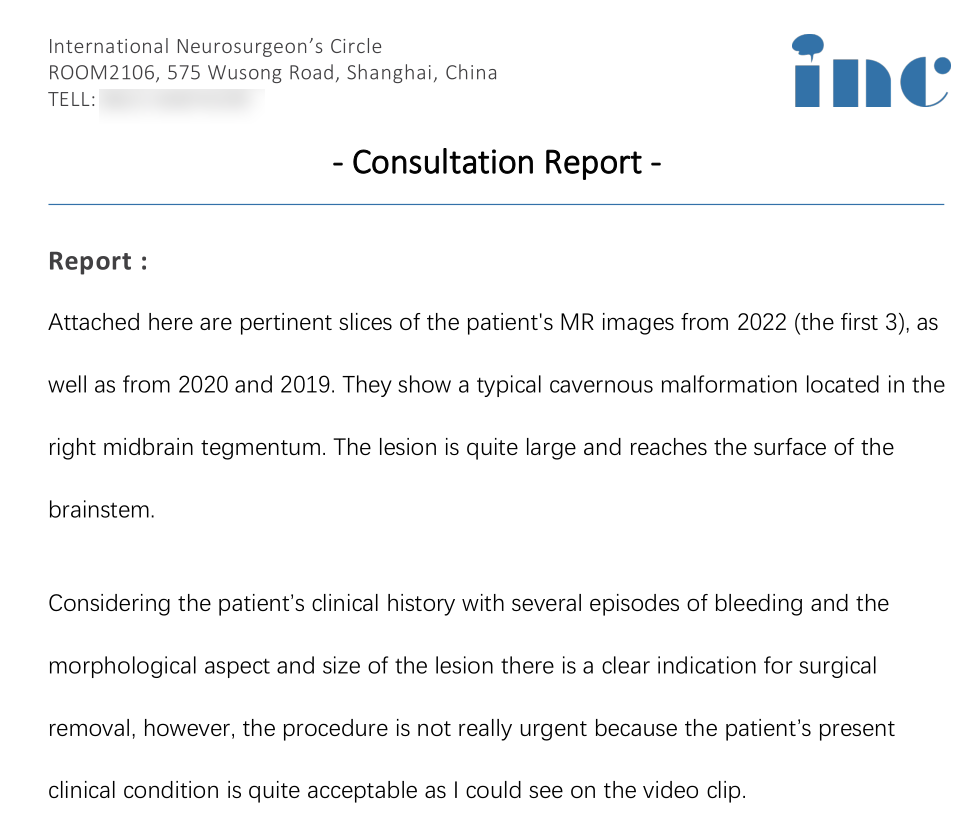Mr. Sun, a 47 year old male with a cavernoma in his midbrain, underwent curative surgery during one of INC's 2022 rounds of surgical demonstrations. After the surgery, INC's Professor Bertalanffy told MR. Sun that he could now return to his normal life.

Before discharge, Mr. Sun and Professor Bertalanffy took a photo together,A German-Chinese surgical cooperation
Protocol of a Sino-German surgical cooperation
On November 11, 2022, at around 12am, by the hand of the Sino-German medical team, Mr. Sun's brainstem cavernoma was safely resected. Right after the surgery was finished, Mr. Sun woke up in the operating room. Professor Bertalanffy check on the patient and told him in Chinese: "It's over!Can you understand? " . "Everything is great!" Just shortly after the surgery, Mr. Sun was able to have a normal conversation with the professor. " . Following the professor's instructions, Mr. Sun moved around his arms and legs without problems.
On the second post-operative day, Mr. Sun was transferred back to the normal ward. He had now new neurological deficits and was generally in a good condition. He was already able to leave his bed, walk around his room, and even play games. For four years, Mr. Sun had battled with his brainstem cavernoma. His fight was finally over, and he could return to the life he knew from before.
Brainstem cavernoma with two episodes of bleeding-Mr. Sun's journey to recovery
Mr. Sun was just 40 years old when he was struck by a sudden episode of dizziness. An examination quickly revealed a cavernous malformation in his brainstem. Because his dizziness quickly subsided, no treatment was performed at the time. That was in March 2018. Exactly two years later, his brainstem cavernoma hemorrhaged for the first time, causing numbness in his left hand and in the left side of his face. It took three to four months before he recovered completely. Again, apart from observation, he wasn't given any treatment. In August 2021, Mr. Sun experienced this second hemorrhage. This time, the numbness was more severe and even extended to his left foot. He complained of soreness and general weakness. When we walked around, he felt a swelling pain in his feet, a sensation somewhat similar to that of stroke victims.

After each of his hemorrhages, his condition had become worse every time. Over the course of four years, he had been to every major hospital in the country seeking advice from the best in the field. Most of them had recommended to continue observation, to not undergo surgery due its risks. Some even suggest that he could undergo surgery, once he accepted that this kind of surgery would cause him to be paralyzed for the rest of his life. . . Before Mr. Sun was admitted by INC, he certainly did not consider to not get surgery, Surgery simply wasn't an option. The brainstem regulates our most vital functions, like breathing, heartbeat, etc. Surgery on the brainstem is extremely delicate, even the most minuscule mistake can have grave consequences. Every time Mr. Sun visited the hospital, he would see many of his fellow patients with a similar disease coming in for follow-up examinations after surgery. Some of them showed very poor quality of life, a few were incapable of taking care of themselves. To Mr. Sun, still basically living a normal life, this kind of outcome was unacceptable.
Screenshot of Professor Bertalanffy's evaluation
Just before Professor Bertalanffy's arrival to China, Mr. Sun read reports about INC's surgical demonstrations program. He did not waste any time and immediately contacted us. Via remote consultation, Professor Bertalanffy quickly evaluated Mr. Sun's case: "Considering the patient's previous history with several episodes of bleeding and the morphological aspect and size of the lesion, there is a clear indication for surgical removal. . . If I perform the surgery I can completely evacuate the lesion from the midbrain. . . I expect that the patient can return to normal life after surgery between 2 and 4 months. "

A change in fortune
Pre-operative planning
Before the surgery, Professor Bertalanffy and his Chinese neurosurgical colleagues discussed the surgery with Mr. Sun, giving him the chance to confirm one more time the details of the procedure and its duration, as well as to ask questions about the duration he would likely have to spend in the ICU and about his post-operative recovery. With respect to the procedure, Professor Bertalanffy would employ a special approach, making an opening behind Mr. Sun's ear, but without shaving his hair. Professor Bertalanffy was even able to use simple Chinese talking to Mr. Sun, asking him to look left and right, move his limbs, etc.
Mr. Sun: "How long will I stay in the ICU? That is, I'm sure I'll go straight to ICU after the surgery. "
Professor Bertalanffy: "Normally, just for one night"
Mr. Sun: "Just one night? "
Professor Bertalanffy: "Yes, one night for observation, then on the second day, you can return to the normal ward. . . "
"Just one night in the ICU? " Mr. Sun felt slightly but pleasantly surprised.
Based on his previous experiences, the repeated poor evaluations of his post-operative prognosis, and the encounters with his fellow patients, he had prepared himself to spend a considerable time in the ICU until the variety of complications after the surgery could be controlled.
Surgical record:cutting-edge technology, smooth Sino-German cooperation pave the way for safe total resection of Mr. Sun's brainstem cavernoma
Cleaning and disinfecting hands
Preparing the instruments
Marking the incision
Preparing the microscope
Studying the patient's latest images
Laying out the procedure
Resection of the brainstem cavernoma
Continuous electrophysiological monitoring providing a safety net during the surgery
Manipulation of the brainstem cavernoma under the microscope
On the first post-operative day, Professor Bertalanffy visited Mr. Sun. His condition was good, both hands were flexible, and he could answer questions clearly. On the second day, Mr. Sun was transferred back to the normal ward. Coma, complete paralysis, infection, he experienced none of the complications he had been so afraid of.
On the fifth day, Mr. Sun was overwhelmed with happiness: "Look, I can walk around again, I've already explored the whole hospital! "
The post-operative pathological test confirmed the lesion being a cavernous malformation of the brainstem. Now, Mr. Sun could completely feel at ease. Not long after, Mr. Sun could be discharged from the hospital. Now, being cured, he is able to work and live as he used to before the onset of his disease.